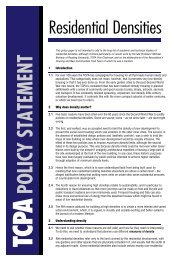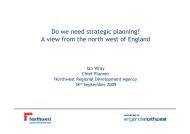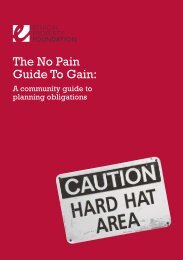Download Connecting England - Town and Country Planning ...
Download Connecting England - Town and Country Planning ...
Download Connecting England - Town and Country Planning ...
Create successful ePaper yourself
Turn your PDF publications into a flip-book with our unique Google optimized e-Paper software.
12 <strong>Connecting</strong> <strong>Engl<strong>and</strong></strong>attracts record levels of private sector investment, contains one of the three most significantfinancial service powerhouses in the world. London is often the first place where people whomake money elsewhere in the world chose to buy property, partly because high-qualityhousing is available (to those who can afford it) <strong>and</strong> partly because of its cultural <strong>and</strong> socialattractions. London has now demonstrated an extraordinary 20-year performance inconsolidating its role as a World City. The consequences of such extremes of performancehelp to exacerbate differences of wealth in the l<strong>and</strong>scape of regional development across<strong>Engl<strong>and</strong></strong>.Major disparities in income, employment <strong>and</strong> performance exist across the country. One countywith a bigger population than many of the core cities, Cornwall, which defines itself as a regionin its own right, is both the poorest <strong>and</strong> the most isolated in terms of journey times <strong>and</strong>accessibility to the rest of the country. In 2001, the Department for Trade <strong>and</strong> Industry <strong>and</strong> theTreasury published their report Productivity in the UK 3: The Regional Dimension. It showed thateconomic disparities in the UK are increasing. The gap between London <strong>and</strong> the North hasgrown by more than 30 per cent since 1997. But importantly the report points to the fact thatthis is not simply a North-South divide. The further one travels away from London, the greaterthe decline in prosperity.Caution needs to be exercised in comparing disparities between the English regions withdisparities between the regions of, say, Germany, given the prominence of London’s financialmarkets in distorting the English picture. It is undoubted that many German cities would be keento possess equivalent financial centres even if this were to exacerbate regional disparities inincome prevailing across the regions as a whole. With bonuses in London’s financial centresperhaps totalling £6billion in 2006 it is entirely unsurprising that disparities of wealth betweenthe English regions are maintained. Even if London’s financial market <strong>and</strong> the emphasis this givesto regional inequalities were removed, substantial differences in wealth, productivity <strong>and</strong> incomelevels between regions would remain. In addition to this, the trends in absolute performance ofregions such as the North East remain of concern <strong>and</strong> must matter to any nation whoseobjective is to support the sustainable development of its economy, society <strong>and</strong> environmentwithin every region. <strong>Connecting</strong> <strong>Engl<strong>and</strong></strong>, therefore, <strong>and</strong> connecting areas that could benefitfrom <strong>and</strong> contribute to the current areas of growth (principally in the South East but alsoelsewhere) has never been more important.Regional disparities are even more apparent in skills – the key factor in future prosperity.London’s working age population contains almost three times as many graduates as that of theNorth East. Participation rates in full-time education range from over 60 per cent in London <strong>and</strong>the South East to fewer than 50 per cent in the North East. 11 HM Treasury<strong>and</strong> Department ofTrade <strong>and</strong> Industry(2001) Productivityin the UK: 3 – TheRegional Dimension.London: HMTreasuryThe Treasury/Department of Trade <strong>and</strong> Industry’s Regional Competitiveness <strong>and</strong> the State of theRegions Report (April 2005) shows that, between 1989 <strong>and</strong> 2003, across <strong>Engl<strong>and</strong></strong> gross valueadded (GVA) per head increased most in the three southern regions – the East, the South West<strong>and</strong> the South East (although not in London) (see Fig. 1.1 above right). More positively, it showssteep falls in unemployment in regions such as the North East <strong>and</strong> the North West <strong>and</strong> a greaterproportion of overseas investment in the northern regions – indicating that for many investorsthe North of <strong>Engl<strong>and</strong></strong> is a good place to do business. There is little evidence that the gapbetween the three southern regions <strong>and</strong> the North or the far South West is narrowing. Keyindicators – business start-ups, health inequalities <strong>and</strong> educational attainment, for example –show the North lagging behind the South. The Northern Way report quantified the productivity
















